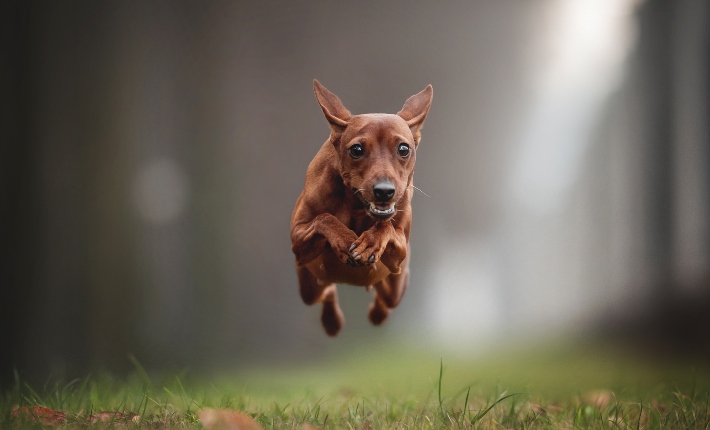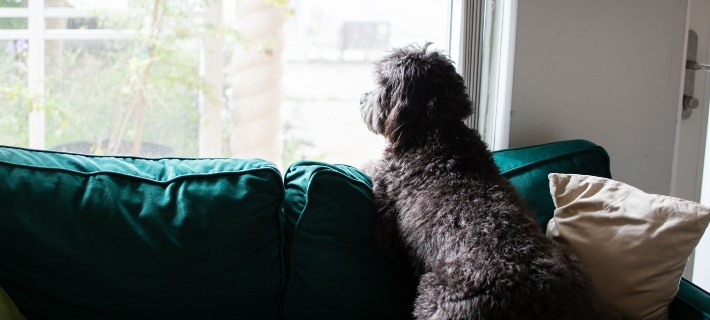How to Train a Reactive Dog: 4 Tips and Tricks
It’s not unusual for your dog to bark when they spot neighborhood cats, hear the mail carrier on the porch, or encounter stressful situations. But when their reaction seems to be a bit too much, it may mean your dog is reactive. A reactive dog will overreact to situations, no matter the intensity.
There can be many reasons why your dog may react the way they do, and their personality also plays a role. When trying to manage your dog’s behavior—or determine whether it’s truly reactive—it’s important to know how to train a reactive dog so you can best manage situations as they arise.
What Is a Reactive Dog?
Dogs who tend to react exaggeratedly to normal situations are typically described as “reactive.” There are a few factors that can lead to reactive behavior in dogs: past negative experiences, lack of socialization, or even environment are just a few examples. When your dog is reactive, they tend to take it to a whole different level—barking for much longer than necessary, displaying an inability to focus on anything else even after the trigger is gone, or even straining against the leash in an attempt to escape or chase.
Reactive dogs may display behaviors similar to dog aggression, stemming from feelings of fear, excitement, or frustration. However, unlike reactivity, dog aggression involves an intent to enter conflict.
Common Signs and Behavior
It’s best to focus on your dog’s body language when trying to measure their reactivity level. Behavior such as barking, growling, lunging, and hunched posture are all common behaviors seen in reactive dogs. These dogs may also pace, spin in circles, whine, or show signs of restlessness. They might also act extremely vigilant in an effort to protect loved ones or their home.
4 Reactive Dog Training Tips
When figuring out how to train a reactive dog, there are several ways to help make their habits more manageable or even eliminate them entirely.
#1: Practice behavioral management: You can’t always control when things happen, but you can do your best to minimize stress triggers. Measures like staying away from busier environments or taking walks earlier or later in the day can help avoid interacting with other people or animals.
#2: Use positive reinforcement: Positive reinforcement dog training, or rewarding your dog for successfully completing a desired behavior, is helpful when managing your dog’s bad habits. Dogs are more likely to react well to treats and praise than they are to yelling or punishment. Rewarding good behavior and ignoring bad behavior can help your dog learn what is and isn’t acceptable.
#3: Utilize desensitization training: Of course, you can’t avoid stressful situations forever. Desensitization is a technique where you slowly expose your dog to the trigger and gradually increase the intensity over time—all in a safe, controlled setting.
For example, if your dog gets stressed on car rides, the first step could be letting them sit in the car without the engine running and rewarding them for calm behavior. Another day, you can work up to a short ride and similarly offer a reward. Eventually, you can advance to longer rides and you guessed it: give plenty of praise and a reward!
#4: Socialize your dog more often: Reactive dogs’ behavior may be because they weren’t properly socialized as puppies. Socialization entails gradually introducing your dog to other dogs, people, and places so they can better acclimate to life around them. Ultimately, it can help your dog get used to interacting with strangers rather than seeing them as a threat.
Ready to React to Reactivity

Like other forms of training, it takes time for your dog to learn—especially if their habits are formed over a long period of time! So, don’t be discouraged if results don’t appear right away. If all else fails, you can always consult a professional for more help. Figuring out how to train a reactive dog may seem tricky at first, but with a little patience and a lot of love, there’s nothing you and your furry friend can’t do.
If learning about reactive dogs has you curious about other dog behaviors, check out these topics:
FOLLOW US!







